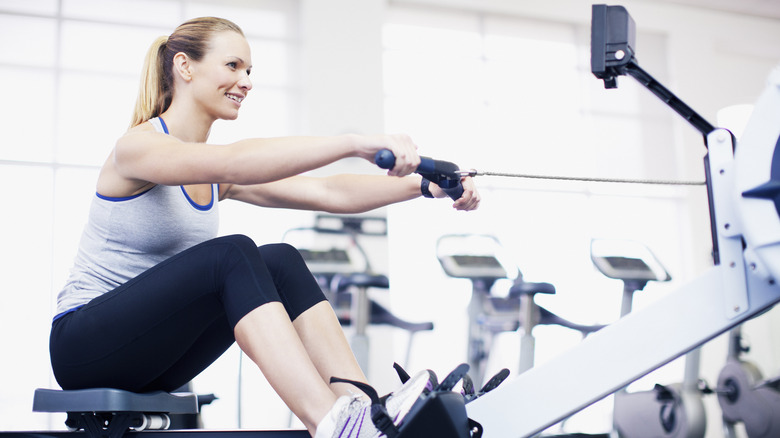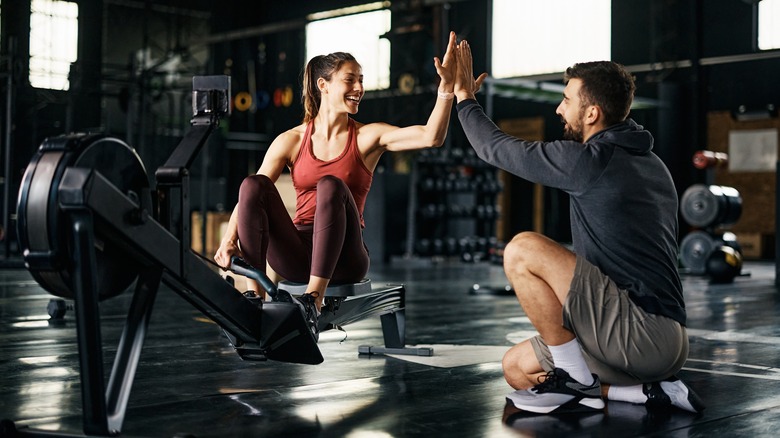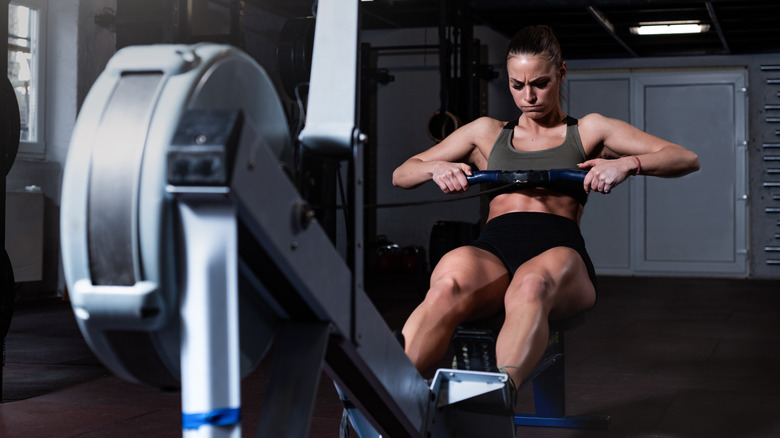Why You Should Incorporate Rowing Into Your Workout Routine
Whether you work out at the gym, a fitness studio, or at home, your exercises likely include some type of cardio activity like running or cycling. Both of these options are great for heart health and weight loss, but they have something else in common as well: They don't do much for the upper body. That means if your goal is to strengthen your arms, shoulders, or back, you'll have to add another exercise to your regimen.
You may want to consider replacing some of your running or cycling time with indoor rowing. If you've ever rowed on a machine before, you already know how effective the activity is when it comes to quickly increasing heart rate. Once the heart rate reaches a certain number, the body will start burning fat for fuel, but this number is different for everyone as it largely depends on age, as MedicalNewsToday explains.
Burning fat when you're trying to lose or maintain your weight is obviously great, but it's just one of several reasons that you should incorporate rowing into your workout routine.
It's a total-body workout
Rowing on a machine involves four positions: the catch, the drive, the release, and the recovery. As your body moves through each position, multiple muscles are activated, making rowing a total-body workout. Annie Mulgrew, vice president and founding instructor of City Row, shared her thoughts on the topic with Women'sHealth. "Rowing ... targets 85% of your body's muscles in order to perform the full movement or stroke properly," she says.
The catch position is when your legs are bent and your arms are positioned above your knees. While in this position, your triceps are activated. As you push backward with your legs while pulling the handle toward your chest, you transition to the drive position and engage your glutes, hamstrings, biceps, and back muscles.
For the finish — when the handle is closest to your chest — your abs work to stabilize your body while your glutes, quads, biceps, and back muscles contract. Last is the recovery position, which is similar to (and precedes) the catch, but your knees aren't bent as much. In this position, the triceps, abs, hamstrings, and calves are engaged.
This simultaneous muscle activation is why rowing increases the heart rate so quickly, according to Catalyst Fitness. As the heart rate increases, your breath quickens, which makes rowing a great aerobic workout in addition to a great full-body workout.
It's low impact
When you consider the ratio of treadmills to rowers in gyms, it's obvious that running is more popular, but not everyone can run without discomfort. WebMD lists runner's knee, shin splints, and plantar fasciitis as some of the many common running injuries that can force people to consider cardio exercises that don't apply pressure to the feet. Other people seek these options because they simply hate running.
Running is considered a high-impact activity since it involves quickly lighting your feet off the ground in a way that can impact the joints, according to the American Sports & Fitness Association. Rowing, on the other hand, is low-impact because the feet don't touch the ground at all and you're seated the entire time, so there's no impact on the joints. A National Library of Medicine study revealed that rowing can even improve joint problems by more than 30%.
And remember, rowing is considered an aerobic exercise, so it can be a great alternative to running with equivalent benefits, as exercise physiologist Chris Dempers explains in Cleveland Clinic. "If you're strictly looking at it as an aerobic exercise ... you can do the rowing machine for half an hour and get a great cardio workout."
It can build muscle, strengthening your body
Regardless of what type of rowing machine you use, rowing always involves some type of natural resistance in the form of water, magnetism, air, or a hydraulic piston. However, some machines give you the option to adjust the resistance level to provide a more strength-oriented workout.
Any form of resistance training can build muscle, but with rowing, most of that muscle building occurs in the legs. The American Fitness Professionals & Associates claims the legs comprise about 70% of the power in each rowing stroke. However, the muscles in the abs, core, back, biceps, shoulders, and triceps can also be strengthened with rowing.
Rowing is a great low-impact, total-body, calorie-scorching workout that can strengthen various muscles in the body. It also provides aerobic benefits, making it a great cardio exercise to incorporate into your workout routine, if it's not already included.



